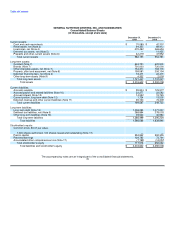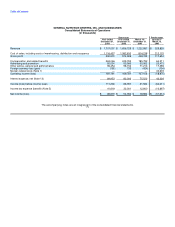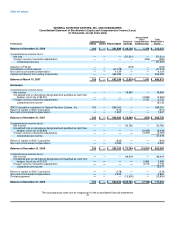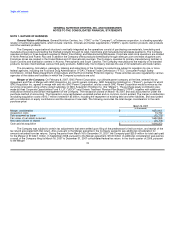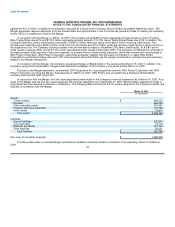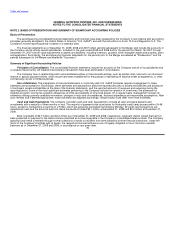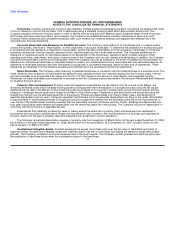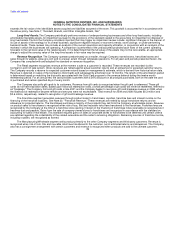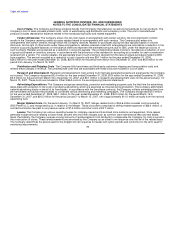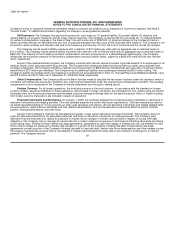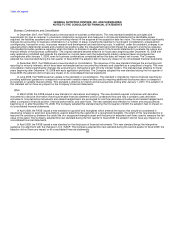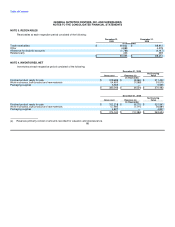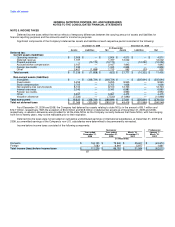GNC 2010 Annual Report Download - page 84
Download and view the complete annual report
Please find page 84 of the 2010 GNC annual report below. You can navigate through the pages in the report by either clicking on the pages listed below, or by using the keyword search tool below to find specific information within the annual report.
Table of Contents
GENERAL NUTRITION CENTERS, INC. AND SUBSIDIARIES
NOTES TO THE CONSOLIDATED FINANCIAL STATEMENTS
exceeds the fair value of the identifiable assets acquired and liabilities assumed of the store. This goodwill is accounted for in accordance with
the above policy. See Note 7, "Goodwill, Brands, and Other Intangible Assets, Net."
Long-lived Assets. The Company periodically performs reviews of underperforming businesses and other long-lived assets, including
amortizable intangible assets, for impairment pursuant to the provisions of the standard related to the accounting for impairment on disposal of
long lived assets. Factors the Company considers important that may trigger an impairment review include: significant changes in the manner of
its use of assets of the strategy for its overall business; significant negative industry or economic trends; store closings; or under-performing
business trends. These reviews may include an analysis of the current operations and capacity utilization, in conjunction with an analysis of the
markets in which the businesses are operating. A comparison is performed of the undiscounted projected cash flows of the current operating
forecasts to the net book value of the related assets. If it is determined that the full value of the assets may not be recoverable, an appropriate
charge to adjust the carrying value of the long-lived assets to fair value may be required.
Revenue Recognition. The Company operates predominately as a retailer, through Company-owned stores, franchised stores and
sales through its website, www.gnc.com and to a lesser extent through wholesale operations. For all years and periods presented herein, the
Company has complied with and adopted the standard on revenue recognition.
The Retail segment recognizes revenue at the moment a sale to a customer is recorded. These revenues are recorded via the
Company's point of sale system. Gross revenues are netted against actual customer returns and an allowance for expected customer returns.
The Company records a reserve for expected customer returns based on management's estimate, which is derived from historical return data.
Revenue is deferred on sales of the Company's Gold Cards and subsequently amortized over 12 months. The length of the amortization period
is determined based on matching the discounts associated with the Gold Card program to the revenue deferral during the twelve month
membership period. For an annual fee, the card provides customers with a 20% discount on all products purchased, both on the date the card
is purchased and certain specified days of every month.
The Company also sells gift cards to its customers. Revenue from gift cards is recognized when the gift card is redeemed. These gift
cards do not have expiration dates. Based upon historical redemption rates, a small percentage of gift cards will never be redeemed, referred to
as "breakage." The Company first sold gift cards in late 2001 and the Company began to recognize gift card breakage revenue in 2008, when
the likelihood of redemption became remote and amounts were not escheatable. Total revenue for 2009 and 2008 includes $0.3 million and
$0.6 million, respectively, related to recognition of gift card breakage revenue.
The Franchise segment generates revenues through product sales to franchisees, royalties, franchise fees and interest income on the
financing of the franchise locations. See Note 20, "Franchise Revenue." These revenues are netted by actual franchisee returns and an
allowance for projected returns. The franchisees purchase a majority of the products they sell from the Company at wholesale prices. Revenue
on product sales to franchisees is recognized when risk of loss, title and insurable risks have transferred to the franchisee. Franchise fees are
recognized by the Company at the time of a franchise store opening. Interest on the financing of franchisee notes receivable is recognized as it
becomes due and payable. Gains from the sale of company-owned stores to franchisees are recognized in accordance with the standard on
accounting for sales of real estate. This standard requires gains on sales of corporate stores to franchisees to be deferred until certain criteria
are satisfied regarding the collectability of the related receivable and the seller's remaining obligations. Remaining sources of franchise income,
including royalties, are recognized as earned.
The Manufacturing/Wholesale segment sells product primarily to the other Company segments and third-party customers. Revenue is
recognized when risk of loss, title and insurable risks have transferred to the customer, net of estimated returns and allowances. The Company
also has a consignment arrangement with certain customers and revenue is recognized when products are sold to the ultimate customer.
78




